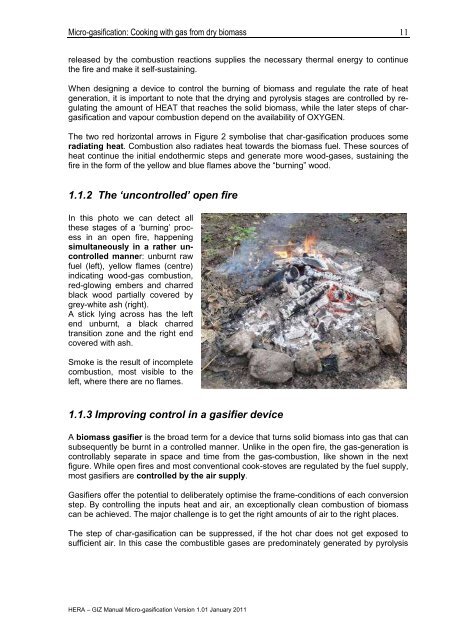Micro-gasification: Cooking with gas from biomass - Amper
Micro-gasification: Cooking with gas from biomass - Amper
Micro-gasification: Cooking with gas from biomass - Amper
You also want an ePaper? Increase the reach of your titles
YUMPU automatically turns print PDFs into web optimized ePapers that Google loves.
<strong>Micro</strong>-<strong><strong>gas</strong>ification</strong>: <strong>Cooking</strong> <strong>with</strong> <strong>gas</strong> <strong>from</strong> dry <strong>biomass</strong><br />
released by the combustion reactions supplies the necessary thermal energy to continue<br />
the fire and make it self-sustaining.<br />
When designing a device to control the burning of <strong>biomass</strong> and regulate the rate of heat<br />
generation, it is important to note that the drying and pyrolysis stages are controlled by regulating<br />
the amount of HEAT that reaches the solid <strong>biomass</strong>, while the later steps of char<strong><strong>gas</strong>ification</strong><br />
and vapour combustion depend on the availability of OXYGEN.<br />
The two red horizontal arrows in Figure 2 symbolise that char-<strong><strong>gas</strong>ification</strong> produces some<br />
radiating heat. Combustion also radiates heat towards the <strong>biomass</strong> fuel. These sources of<br />
heat continue the initial endothermic steps and generate more wood-<strong>gas</strong>es, sustaining the<br />
fire in the form of the yellow and blue flames above the ―burning‖ wood.<br />
1.1.2 The ‘uncontrolled’ open fire<br />
In this photo we can detect all<br />
these stages of a ‗burning‘ process<br />
in an open fire, happening<br />
simultaneously in a rather uncontrolled<br />
manner: unburnt raw<br />
fuel (left), yellow flames (centre)<br />
indicating wood-<strong>gas</strong> combustion,<br />
red-glowing embers and charred<br />
black wood partially covered by<br />
grey-white ash (right).<br />
A stick lying across has the left<br />
end unburnt, a black charred<br />
transition zone and the right end<br />
covered <strong>with</strong> ash.<br />
Smoke is the result of incomplete<br />
combustion, most visible to the<br />
left, where there are no flames.<br />
1.1.3 Improving control in a <strong>gas</strong>ifier device<br />
A <strong>biomass</strong> <strong>gas</strong>ifier is the broad term for a device that turns solid <strong>biomass</strong> into <strong>gas</strong> that can<br />
subsequently be burnt in a controlled manner. Unlike in the open fire, the <strong>gas</strong>-generation is<br />
controllably separate in space and time <strong>from</strong> the <strong>gas</strong>-combustion, like shown in the next<br />
figure. While open fires and most conventional cook-stoves are regulated by the fuel supply,<br />
most <strong>gas</strong>ifiers are controlled by the air supply.<br />
Gasifiers offer the potential to deliberately optimise the frame-conditions of each conversion<br />
step. By controlling the inputs heat and air, an exceptionally clean combustion of <strong>biomass</strong><br />
can be achieved. The major challenge is to get the right amounts of air to the right places.<br />
The step of char-<strong><strong>gas</strong>ification</strong> can be suppressed, if the hot char does not get exposed to<br />
sufficient air. In this case the combustible <strong>gas</strong>es are predominately generated by pyrolysis<br />
HERA – GIZ Manual <strong>Micro</strong>-<strong><strong>gas</strong>ification</strong> Version 1.01 January 2011<br />
11
















